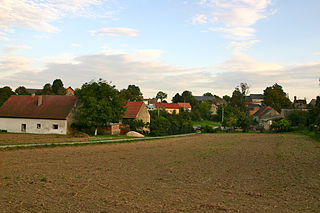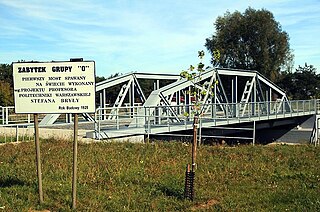
Cultural heritage is the heritage of tangible and intangible heritage assets of a group or society that is inherited from past generations. Not all heritages of past generations are "heritage"; rather, heritage is a product of selection by society.

Zwierzyn is a village in Strzelce-Drezdenko County, Lubusz Voivodeship, in western Poland. It is the head of the gmina called Gmina Zwierzyn. It lies approximately 6 kilometres (4 mi) south-east of Strzelce Krajeńskie and 25 km (16 mi) north-east of Gorzów Wielkopolski.

Jałowiec is a village in the administrative district of Gmina Lubań, within Lubań County, Lower Silesian Voivodeship, in south-western Poland. Prior to 1945 it was in Germany and had the name Wingendorf.

Protected areas of Poland include the following categories, as defined by the Act on Protection of Nature of 16 April 2004, by the Polish Parliament:

Lisięcice is a village located in the Opole Voivodeship, Głubczyce County, Gmina Głubczyce. It lies approximately 8 kilometres (5 mi) north-east of Głubczyce and 46 km (29 mi) south of the regional capital Opole.

Zadzim is a village in Poddębice County, Łódź Voivodeship, in central Poland. It is the seat of the gmina called Gmina Zadzim. It lies approximately 16 kilometres (10 mi) south-west of Poddębice and 43 km (27 mi) west of the regional capital Łódź.

Czyżowice is a village in the administrative district of Gmina Prudnik, within Prudnik County, Opole Voivodeship, in south-western Poland, close to the Czech border. It lies approximately 5 kilometres (3 mi) north of Prudnik and 42 km (26 mi) south-west of the regional capital Opole. Historically located in Upper Silesia, in the Prudnik Land.

Dębowiec is a village in the administrative district of Gmina Prudnik, within Prudnik County, Opole Voivodeship, in south-western Poland, close to the Czech border. It lies approximately 6 kilometres (4 mi) south-west of Prudnik and 51 km (32 mi) south-west of the regional capital Opole. Historically located in Upper Silesia, in the Prudnik Land.
Cultural heritage of Serbia represents the totality of national cultural heritage in Serbia as defined by Serbia's Law on Cultural Goods. Some of national heritage sites in Serbia are also World Heritage Sites.

Cultural property protection in Poland

The osiedleOld City is the oldest historic district of the city of Zamość. It is one of World Heritage Sites in Poland. According to UNESCO, this monument value lies in it being "an outstanding example of a Renaissance planned town of the late 16th century, which retains its original layout and fortifications and many buildings of particular interest, blending Italian and Central European architectural traditions.". The Medieval Town has an area of 75 ha and a buffer zone of 200 ha.

Ostrowo Szlacheckie Palace is a historic palace in Ostrowo Szlacheckie. Since 1977 national heritage site.

Medieval Town of Toruń is the oldest historic district of the city of Toruń. It is one of Poland's World Heritage Sites. According to UNESCO, its value lies in its being "a small historic trading city that preserves to a remarkable extent its original street pattern and outstanding early buildings, and which provides an exceptionally complete picture of the medieval way of life". The Medieval Town has an area of 60 ha and a buffer zone of 300 ha. It is composed of the Toruń Old Town, Toruń New Town, and the Toruń Castle.

The Maurzyce Bridge is a bridge over the Słudwia River in Central Poland. It is known as the first entirely welded road bridge and the second welded bridge of any category in the world. The bridge is located close to the village of Maurzyce near Łowicz in Łódź Voivodeship.
Registry of Cultural Property in Poland is a heritage register for Polish cultural property. It is maintained by the 16 voivodeship offices for cultural property protection headed by a voivodeship cultural property conservator acting on behalf of the voivode as the first-tier registration organ. In addition, selected units of territorial self-government: gminas, cities with county rights and counties have used an option to appoint a communal, municipal, city or county cultural property conservator, with some tasks of the voivodeship conservator usually delegated to such an office under an agreement with the respective voivode. The cultural property data is processed at the national level by the National Institute of Cultural Heritage, the latter also operating the National List of Intangible Cultural Heritage on behalf of the minister responsible for national cultural heritage, while all the abovementioned institutions are overseen by the General Cultural Property Conservator, an office fulfilling the tasks of the second-tier registration organ, held by a secretary or an undersecretary of state at the ministry responsible for national cultural heritage and acting on behalf of the minister.
Culture park, in Poland, is a designation in the heritage register for cultural landscape-level objects of cultural heritage in Poland.

The Małopolska Institute of Culture is a regional cultural institution engaged in promoting and supporting the culture of Małopolska. The institute was founded in 2002 and is located in Kraków. Its main focus is integrating diverse small regional cultural institutions - museums, archives or local cultural centres.

The Church of St. Peter and St. Paul is a Lutheran church and a historical landmark in the town of Pabianice in central Poland. Constructed in the early nineteenth century to cater to the spiritual needs of the growing Protestant population of the rising industrial town, the church now serves a small Lutheran community in what is a predominantly Catholic area. Since 2010 the church has been the seat of the bishop of the Lutheran Diocese of Warsaw.

Juliusz Stefan Norblin de la Gourdaine (1892-1952), known as Stefan Norblin, was a Polish visual artist, painter, caricaturist, illustrator, poster designer, and interior, architectural and fashion designer. He created, among others, modernist and Art Nouveau advertising posters as well as Art Deco paintings. He also realised the interior decoration (frescoes) of several rooms of the Umaid Bhawan Palace in Jodhpur, Rajasthan, India.
















